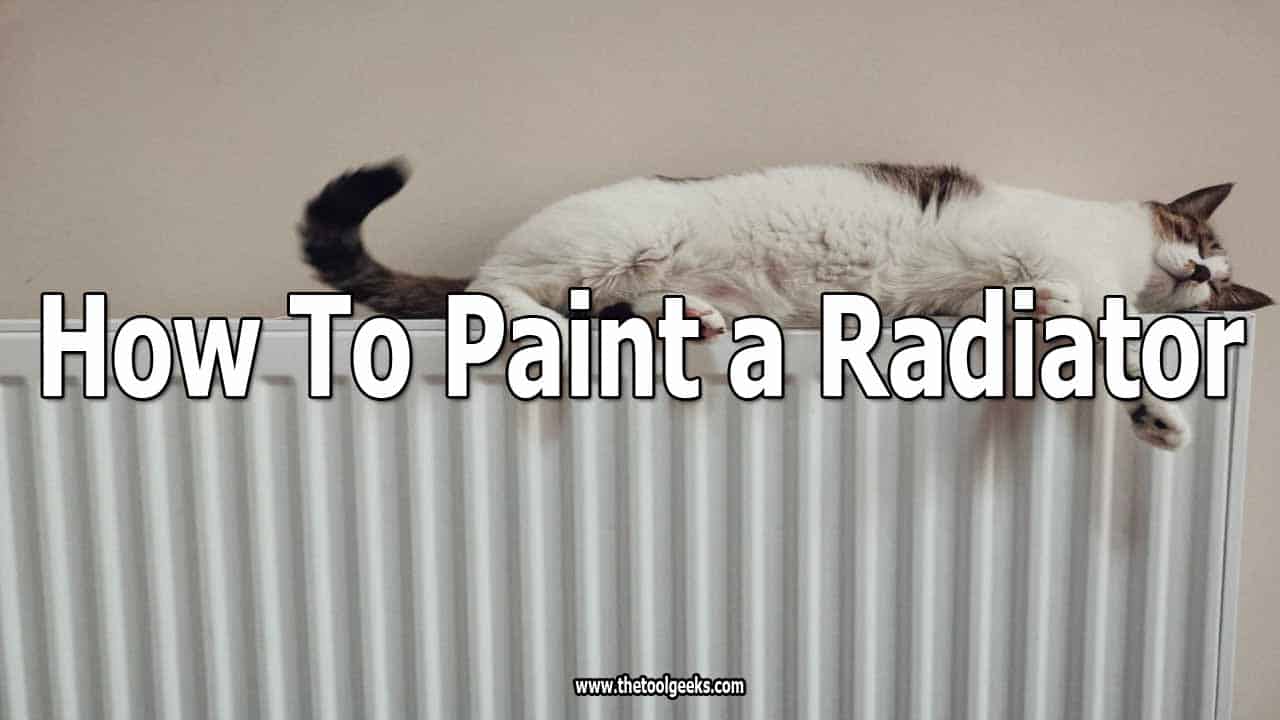How to Paint a Radiator (3 Easy Steps): Use Any Color You Want!
TheToolGeeks.com is a participant in the Amazon Services LLC Associates Program and other affiliate advertising programs. We may earn from qualifying purchases. (Learn More).
Is your radiator starting to chip off or lose its paint job? If yes, then you should read this article. Rusty radiators can give the corner of your room that unsightly look.
We are sure you wouldn’t like to have sore sights in your home. So what do you do when your radiator starts to chip off? Well, you should have it be repainted and the plus side is you can do it yourself. Don’t fret. We got your back.
In this article, we are going to teach you everything you need to know about painting your radiator to make it look as good as new. If you are ready, scroll down, and let’s get to it.
Jump To Page Contents:
What is a Radiator?
Radiators otherwise known as home radiators are metallic machines designed to emit heat into a home, room, or space by transferring heat from one source to another.
Think of a radiator as an air conditioner. Only that the air conditioner reduces the temperature of the room by making it cold while the radiator does the exact opposite.
Most radiators get heat from the water. The radiator then heats the water to produce steam. It uses the heat that is produced to warm up the air in the room.
What Causes Paint to Chip Off on Radiators?
After using your radiator for a while, the paint will start to chip off. The duration before this chipping starts depends on different reasons. The paint on your radiator chips off for the following reasons;
- Time takes its toll. No matter how beautiful and durable your paint is, it will eventually chip off after some time.
- Dirt. If the paint on the radiator starts to chip off, it could be because of dirt or dust particles. Like most other tools and home appliances, the radiator needs to be cleaned regularly.
- Moisture. The main function of the radiator is to warm up the room basically through steam. The constant release of steam especially from a hot water radiator will cause the paint to chip off after a while.
- Bad paint. If your radiator was initially coated with the wrong paint, chances are the paint will come off very early.
Related Read — Kitchen Cabinet Paint Sprayers Review
Why Should You Paint Your Radiator?
I think the question here is why shouldn’t you? Asides from the obvious fact that painting your radiator makes it look new, painting your radiator:
- Will increase the durability of your radiator.
- Is a good part of taking care of your radiator. Think of it this way. Since your radiator makes you feel good, painting it will make it feel good too.
What Tools Do You Need to Paint Your Radiator?
- A paint sprayer or a paintbrush
- A putty knife
- Sandpaper
- An appropriate Primer
- Paint
- A pair of work gloves
- Safety gear (a pair of gloves, a face mask, and goggles)
- Masking tape
- Rags
Related Read — Review of Fence Sprayers
What Type of Paint and Primer Should You Use on Your Radiator?
Painting your radiator is very different from any other household paint job. It’s different from painting your walls or floors.
The type of primer and paint you will use for your radiator has to be able to withstand the high temperature of the radiator and resist rust from the metal.
We recommend the “Rust-Oleum High Heat” This primer isn’t costly and it can withstand over 2000 degrees Fahrenheit.
You also need paint that can cope with high temperatures. If you get normal paint, you might get a clean job but as soon as you turn on your radiator, be sure the paint will start to bubble and peel off. If you will be going to the paint store yourself, ask the seller there for paint made for radiators.
Related Read — Chalk Paint Sprayers Review
Should You Use a Paintbrush or a Paint Sprayer to Apply Paint to Your Radiator?
Either you use a paintbrush or a paint sprayer depends on which of the two you have available the one you are familiar with, and the one that makes your work easier.
For us, we prefer to use a paint sprayer. This is because the radiator has curves, edges, and tight space that a regular paintbrush might not get to.
A paint sprayer will apply the paint evenly across all surfaces regardless of how difficult they are to reach. Also, a paint sprayer is time and effort efficient.
You will be done in no time. Since a paintbrush will also do a good job depending on your skill and experience with it, your choice ultimately depends on you.
Related Read — Review of Gravity-Feed Paint Sprayers
How to Prepare Your Radiator for a Paint Job
You need to prep the radiator before painting.
Step One: Switch The Radiator Off
The first thing to do is to switch off the radiator and let it cool. To do this, turn the control valve on your radiator till it gets to the “off” position and then leave the radiator for about 30 minutes before you go ahead.
The control valve on most radiators is usually located around the base of the radiator. It looks like a small protruding pole. Turn the valve clockwise till you get to “0.” If your valve isn’t numbered, just keep turning it clockwise till you can’t turn it anymore.
Step Two: Cover Vents
Use duct tape or masking tape to cover the vents, knobs, valves, and other delicate parts of the radiator which you don’t want to paint to get on. If paint gets on any of these parts of the radiator, it will become difficult to get them to work well.
If you don’t want the paint to get on the floor and walls around the radiator, you should cover those areas too. Use masking tape and paper to cover the walls. You can place large nylon or board on the floors to prevent paint stains. Ensure that the material you use as a cover is waterproof.
Related Read — Oil vs. Water-Based Paint
Step Three: Scrape Off Loose Metal
Scrape off any loose metal, or old paint on the radiator. This is where your putty knife and sandpaper come in. Use the putty knife to remove the mass of metal and paint from the radiator.
Then use the abrasive side of the sandpaper to scrub against the surface of the radiator till you see a paint-free surface.
For the sandpaper, you should start with coarse sandpaper of 50 or 60-grit. Then work your way up to a finer grit. To learn how to sand, click the link below to read the article on this website. “Click Here”
How To Paint a Radiator
If you have carefully prepped the radiator and the surrounding area, then you are ready to paint. This part of your task is fun but you should also exercise caution while painting.
Apply Primer
The first thing to do is to apply the primer on the radiator. Remember to only use a primer that can withstand high temperatures. Load up your primer in the paint sprayer, keep a distance of about 12 inches from the radiator, and pull the trigger to apply the primer.
Don’t keep your sprayer pointed in a certain direction for too long. If you are using a paintbrush, use a thin brush to apply the primer on the radiator.
Ensure the primer dries before you paint. This might take up to a day depending on the primer you get. See the container of the primer for more details.
Paint the radiator
Use your sprayer or brush to apply the paint on the radiator leaving as much coat as you require. Two or three coats should be good enough.
Apply the first paint coat evenly. Let it dry for about 10 minutes before applying another coat. Check the container of the paint for additional details.
Let The Paint Dry Off
Let the paint dry off completely and clean your work station. Then take a few steps backward and look at your work. You should be pleased.
Related Read — How To Remove Latex Paint From Carpets?
Tips and Pointers to Get a Good Paint Job on Your Radiator?
- Take your time to paint evenly.
- Use the right primer and paint.
- If you are using a sprayer, keep a 12-inch distance between the spray gun and the radiator,
There you have it. You should be able to paint your radiator by yourself. It’s not difficult, so have a go at it. Have a great painting experience.
Amazon and the Amazon logo are trademarks of Amazon.com, Inc, or its affiliates.

